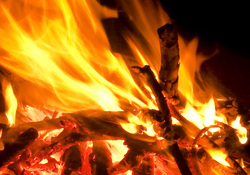The 'Throw fuel on the campfire' story

When explaining this paradigm to patients I often use the analogy of a camp fire. To keep the campfire burning it has to continue to receive fuel. Keep throwing fuel on the campfire and it will keep burning.
Throw lots of fuel on and there will be lots of flames and the coals will be bright red hot. Starve the fire of fuel and it will eventually go out.
The coals would represent the pathophysiological process that underlies the production of the sensitising soup of hormones and neurotransmitters within the nerve that produce the sensitisation of the nociceptors and other receptors in the epineurium, perineurium and endoneurium, and the flames represent the pain experienced.
If fuel is continually thrown on the fire; if the fire is repeatedly kindled; then it will not go out. If the patho-neuro-physiology is repeatedly kindled; the process will continue and the sensory receptors and nociceptors of the nerve trunk will remain sensitised.
If the coals are red hot any fuel thrown on the fire will ignite flames; but if the coals cool down sufficiently then twigs thrown on the fire will not ignite (unless we throw on some gasoline) and when it is even cooler gasoline will not ignite either. The hotter the coals the less fuel is required to produce a flare of flames.
In this analogy the twigs and branches thrown on the fire are the normal movements of life; reaching, carrying, walking. Gravity. It is important to recognise that in some nerve pain presentation these usually innocuous activities repeatedly kindle the painful pathophysiology. Repeated mechanical loading kindles the pathophysiology.
We cannot, and should not, eliminate these activities (and gravity will never go away in our lifetimes); but we can modify the way we do them and avoid the provocative mechanical loading component of the movement.
As the fire is starved of fuel the temperature gradually subsides; but if fuel is still thrown on the fire while the coals are red hot the fire will be re-kindled; the flames (and pain) will flare again.
If the fire is starved of fuel for long enough the coals will become just warm embers; twigs will not ignite any more. When it becomes cooler again, even gasoline or methylated spirits will not ignite.
In the nerve protection paradigm as the underlying neuropathophysiology subsides; the intra-neural swelling subsides and the complex soup of sensitising neurotrasmitters is diluted; as the pain receptor density diminishes; the nerve can move into the previously painful range without provoking a reaction; without provoking pain.
The injured person may then be able to successfully return to previously provocative activities without fear of provoking the pain again.
The long period of pain in the limb will almost certainly have left the muscles of the region weaker and so a strengthening exercise programme may be initiated.